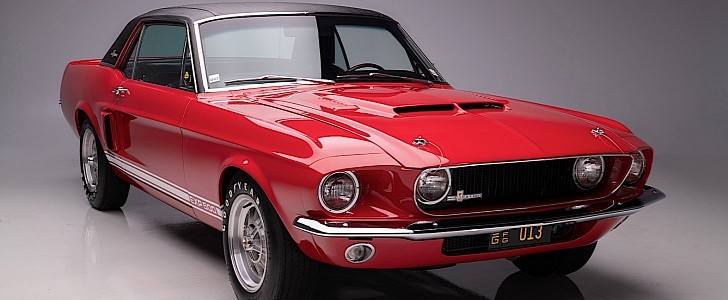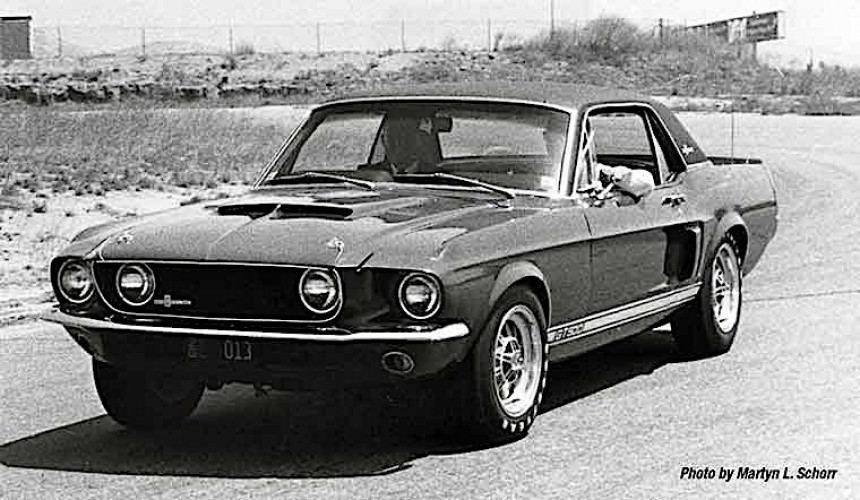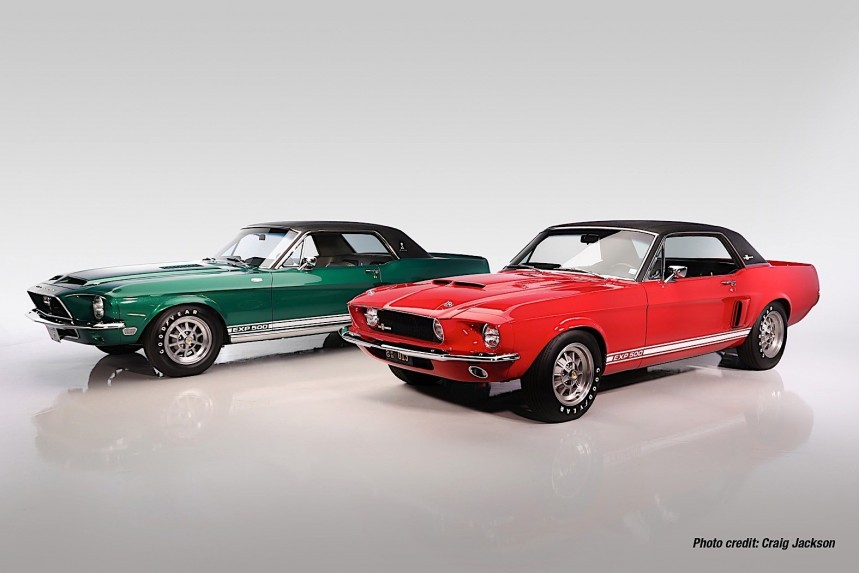The only hardtop coupe GT500 built in 1967, this prototype nicknamed Little Red is an important piece of Mustang history that disappeared for decades. It resurfaced as a pile of scrap metal when few thought it would ever be found, and was ultimately restored to its former glory.
Out of all the performance versions of the first-generation Mustang, the Shelby GT500 is without a doubt the most iconic. After the success of the GT350, Ford and Shelby American decided to up the ante by developing an even more impressive model. Based on the revamped, 1967 ‘Stang, but thoroughly upgraded and extensively redesigned, the GT500 was a thoroughbred 2+2 grand tourer that could rival much more expensive European counterparts in terms of style and performance.
Although the production version was only available in the newly introduced fastback body version with its swept-back rear window and unique ventilation louvers, one of the very first prototypes was developed around a standard hardtop.
It all started in late-1966 when Carroll Shelby and his crew received a 1967-spec GT coupe that was unique in more ways than one - even before they started modifying it.
It went down as the only GT coupe delivered with dual-quad carburetors, the first 428-ci (7.0-liter) FE-equipped hardtop that was ever put together at Ford’s San Jose assembly plant, the first hardtop to feature a 428, and the only 1967 Mustang with a standard coupe body that was supplied with this engine straight from the factory.
Once it arrived at the Shelby American shop in Venice, California, chief engineer Fred Goodell supervised the car’s transformation. It was fitted with bespoke components developed for the upcoming GT500. While the body got a new, fully independent rear suspension system and front disc brakes, the body was outfitted with a redesigned, elongated front end, a new hood, an embedded rear spoiler, side scoops, on the rear quarters, and even the iconic horizontal taillights sourced from a Mercury Cougar. Except for the black vinyl top, it looked exactly like the ’67 GT500.
Next, the 428 FE engine known as the Police Interceptor was tweaked to squeeze out more power. This particular unit that came with the coupe became a testbed for many experimental components that didn’t make it to the GT500’s production motor, such as a Paxton supercharger.
As you would expect from a Caroll Shelby-developed vehicle, this unique GT500 was blistering fast but, unfortunately, no official figures were ever released. What we do know is that it was painted Candy Apple Red, which led to its nickname.
The Little Red was a fascinating car for many, including Ford’s Los Angeles District Manager Lee S. Grey. The story goes that he borrowed the car from Shelby for a few weeks to test the public reaction to a Little Red-inspired regional special. The feedback was more than positive, and the result was the 1968 California Special.
For several months, the car became Fred Goodell's daily driver, but he and the Shelby team continued testing components and several powertrain combinations. In the end, Ford and Shelby American decided that the production version of the GT500 was only going to be available as a fastback coupe and Little Red was shipped to Kar Kraft where it continued its test mule career for a short while. Like many experimental prototypes, it was set to be destroyed, but it somehow avoided the crusher. What exactly happened remained a mystery and over the next half-century, Little Red became a myth. Rumors about its existence surfaced now and again, leading many Mustang fanatics to embark on unsuccessful treasure hunts.
There was a second experimental GT500 built in 1968 called Green Hornet. This car also survived and was tracked down by Craig Jackson, chairman and CEO of Barrett-Jackson. Along with restoration specialist Jason Billups, he began the painstaking process of restoring it and during that time, they managed to pick up the trail of its older, more notorious sibling.
In 2018, the pair made the discovery of their lifetimes when they located Little Red rusting away in a North Texas field. Its front end was missing, the suspension was a pile of rusted junk and what was left of its bodywork was in a sorry state. Jackson bought the car immediately from the owner who had no idea what he had on his property, and proceeded to restore it.
Both Green Hornet and Little Red were brought back to their original 1960s condition, thanks to the work of Jason Billups and his team. The fully restored cars made their public debut in January 2020 at an event organized in collaboration with Ford.
If you want to learn more about this important piece of both Shelby and Mustang history, we recommend watching the Barrett-Jackson video below.
Although the production version was only available in the newly introduced fastback body version with its swept-back rear window and unique ventilation louvers, one of the very first prototypes was developed around a standard hardtop.
It all started in late-1966 when Carroll Shelby and his crew received a 1967-spec GT coupe that was unique in more ways than one - even before they started modifying it.
It went down as the only GT coupe delivered with dual-quad carburetors, the first 428-ci (7.0-liter) FE-equipped hardtop that was ever put together at Ford’s San Jose assembly plant, the first hardtop to feature a 428, and the only 1967 Mustang with a standard coupe body that was supplied with this engine straight from the factory.
Once it arrived at the Shelby American shop in Venice, California, chief engineer Fred Goodell supervised the car’s transformation. It was fitted with bespoke components developed for the upcoming GT500. While the body got a new, fully independent rear suspension system and front disc brakes, the body was outfitted with a redesigned, elongated front end, a new hood, an embedded rear spoiler, side scoops, on the rear quarters, and even the iconic horizontal taillights sourced from a Mercury Cougar. Except for the black vinyl top, it looked exactly like the ’67 GT500.
As you would expect from a Caroll Shelby-developed vehicle, this unique GT500 was blistering fast but, unfortunately, no official figures were ever released. What we do know is that it was painted Candy Apple Red, which led to its nickname.
The Little Red was a fascinating car for many, including Ford’s Los Angeles District Manager Lee S. Grey. The story goes that he borrowed the car from Shelby for a few weeks to test the public reaction to a Little Red-inspired regional special. The feedback was more than positive, and the result was the 1968 California Special.
For several months, the car became Fred Goodell's daily driver, but he and the Shelby team continued testing components and several powertrain combinations. In the end, Ford and Shelby American decided that the production version of the GT500 was only going to be available as a fastback coupe and Little Red was shipped to Kar Kraft where it continued its test mule career for a short while. Like many experimental prototypes, it was set to be destroyed, but it somehow avoided the crusher. What exactly happened remained a mystery and over the next half-century, Little Red became a myth. Rumors about its existence surfaced now and again, leading many Mustang fanatics to embark on unsuccessful treasure hunts.
In 2018, the pair made the discovery of their lifetimes when they located Little Red rusting away in a North Texas field. Its front end was missing, the suspension was a pile of rusted junk and what was left of its bodywork was in a sorry state. Jackson bought the car immediately from the owner who had no idea what he had on his property, and proceeded to restore it.
Both Green Hornet and Little Red were brought back to their original 1960s condition, thanks to the work of Jason Billups and his team. The fully restored cars made their public debut in January 2020 at an event organized in collaboration with Ford.
If you want to learn more about this important piece of both Shelby and Mustang history, we recommend watching the Barrett-Jackson video below.









